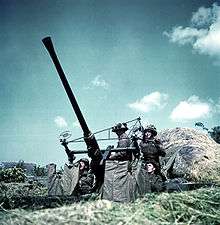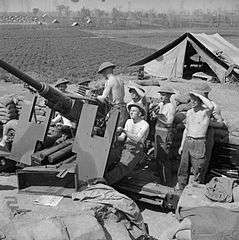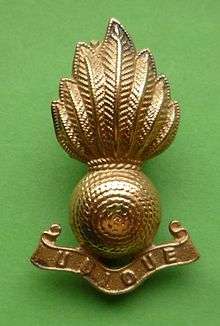26th Light Anti-Aircraft Regiment, Royal Artillery
26th Light Anti-Aircraft Regiment, Royal Artillery (26th LAA Rgt) was a part-time unit of Britain's Territorial Army (TA) formed in Derby (Derbyshire) just before the outbreak of World War II. The regiment then served during the initial stages of the war, but was transferred to take part in the later North African Campaign and eventually the Italian Campaign. The regiment was then placed in suspended animation (SA) in 1946 until they were reformed in 1947, and finally disbanded in 1954 just before Anti-Aircraft Command had the same fate.
| 26th LAA Regt, RA 526th LAA Regt, RA | |
|---|---|
 Cap badge of the Royal Artillery under King George VI | |
| Active | 1939—1945 1947—1954 |
| Country | |
| Branch | |
| Type | Anti-aircraft artillery |
| Role | Light Anti-Aircraft artillery |
| Size | Regiment |
| Part of | 58th (Midland) Anti-Aircraft Brigade (TA) |
| Regimental Headquarters | Derby, Derbyshire |
| Engagements | World War II |
Formation

In 1938 following the Munich Crisis, the anti-aircraft (AA) branch of the Royal Artillery (RA) was rapidly expanded following a report which presented the need for more modern AA defences. The majority, in-fact almost all, AA units were provided by the TA and covered the United Kingdom including Northern Ireland[Notes 1]. Between 25 and 27 August 1939 the new 26th Light Anti-Aircraft Regiment, Royal Artillery (26 LAA Rgt) was formed in Derby with all three batteries based in the city as a "mobile reserve" unit. Following formation, the regiment was assigned to the Hucknall based 50th Light Anti-Aircraft Brigade which only contained that regiment plus supporting elements.[1][2][3][4][5][6][7]
After formation, the regiment was organised as;[3][4][6][8][7]
- Regimental Headquarters (RHQ) in Derby
- 114th Light Anti-Aircraft Battery (LAA Bty)
- Battery Headquarters (BHQ), 317, 318, and 319 AA Trps
- 115th LAA Bty
- BHQ, 320, 321, and 322 AA Trps
- 116th LAA Bty
- BHQ, 323, 324, and 325 AA Trps
Before mobilisation, the regiment was the only TA LAA unit commanded by the 2nd Anti-Aircraft Division which oversaw the AA defence for Northern East Anglia, the East Midlands, and the Humber. After the regiment was formed, there were 6 QF 3-inch 20 cwt LAA guns, 12 QF 2-pdr auto-cannons, and 88 Light machine-guns under the division's control, most of which belonged to the regiment. After being equipped, the regiment was designated as a "mobile reserve" regiment and placed under the administrative command of West Riding Area, Northern Command.[1][2][3][4][5][6][9][10][11][12][13]
World War II
As international tensions reached their boiling point, Adolf Hitler's Third Reich declared war on the Republic of Poland after their refusal to cede the old German port city of Danzig[Notes 2] on 1 September 1939. (See: Danzig Crisis) On 1 September war was declared between the two nations, and in accordance with the Anglo-Polish Agreement of Mutual Assistance, the United Kingdom declared war on Germany two days after the invasion began.
Mobilisation & Phoney War
When the British Armed Forces were mobilised on 3 September 1939, the regiment was consolidated in Derby and placed on home service in the light AA defence role. The first issue of the regiment was the worrisome shortage of light AA guns. During this period, AA command had only 253 our of the 1,200 guns requested, most of which were on lease from the Royal Navy like the Oerlikon 20 mm cannon, older QF 3-inch 20 cwt, or the smaller QF 2-pounder naval gun. Of the best LAA guns, the Bofors 40 mm gun, there were only 76. By the end of 1939, the amount of light AA guns were expanded to 510, and by 1940 this was expanded to just 549, and by May 1941 there were 940 light guns.[13][14]
After the regiment was mobilised, there were only 6 guns in service throughout the entire unit, which was tasked with covering the city of Derby (Derbyshire). During the period between September 1939 and May 1940, known as the 'Phoney War', the regiment along with most of AA command was able to be equipped with more modern equipment and reach full strength through the Militia[Notes 3].[13][15]
On 14 February 1941, the regiment went through a small re-organisation, losing 114 Bty which deployed overseas and later joined the 13th HAA Regt which at this time was based in Gibraltar under the 15th Anti-Aircraft Brigade, itself under Gibraltar Command. As a result of this loss, the regiment gained 103 Bty from 32nd LAA Regt based in Falkirk (Scotland).[7][16][17]
The Levant

On 1 December 1941 the regiment had moved to Palestine and joined the newly formed Ninth Army which was being formed in that area. In September 1941, General Officer Commanding, Palestine, Transjordan, and Cyprus Command was in the process of re-organising, expanding, and re-naming to become the Ninth Army which at this time was under the command of Middle East Command. After formation of this new army, the regiment was placed under command of the officer in-charge of the Royal Artillery units, designation as Brigadier Royal Artillery, Ninth Army. During this period, the army was also referred to as Middle East Forces.[1][2][4][18][19][20]
After moving to Palestine, the regiment was joined by the 78th (1st East Anglian) HAA, 91st HAA (from England), 87th HAA (from Egypt), 200th (Czechslovak) LAA Regt, and 1st Palestine LAA Bty which had been in the area or sent to reinforce the army during their offensive on the east portion in Palestine and west Syria. In July 1943, these regiments joined the newly formed 20th Anti-Aircraft Brigade which recently arrived from England. During this period, the regiment (less 103 Bty) was tasked with defending the area around the towns of Haifa, Beirut, and Tripoli which was designated as 'AA Defence Area Levant' and equipped with 24 x 40mm AA guns. The battery which was not in the area was 103 LAA Bty which was separated and based in Cyprus with 4 x 20mm AA gun & 15 x 40mm guns.[2][19][21][22][23][24]
Syria
Just one month after being assigned to the 20th AA Brigade, on 6 August 1943 the regiment was moved to HQ RA, 8th Indian Infantry Division and moved into Syria.[2][19][20] Just before their next move, the regiment was re-organised in preparation for service in Italy into:[4][8][25][26][27]
- Regimental Headquarters (RHQ)
- x2 Light Warning Signal Sections (4 men + 2 Trucks each, provided by the Royal Corps of Signals)
- 103 LAA Bty
- Bty HQ
- 277, 278, & 279 AA Trps (each troop had 6 sections, each of 1 guns + 1 LMG, total of 6 guns + 6 LMGs)
- 115 LAA Bty
- Bty HQ, 320, 321, & 322 AA Trps
- 116 LAA Bty
- Bty HQ, 323, 324, & 325 AA Trps
- 26th Regt Light Anti-Aircraft Workshop, Royal Electrical and Mechanical Engineers
- Workshop HQ
- x3 Battery Workshops (attached to each on operations)
- Telecommunications Workshop (authorised when the regiment was issued with radar)
Italy

On 19 September 1943 the regiment embarked at the Port of Alexandria, Egypt due for Italy and disembarked in Taranto (south-east coast) on the 24th along with the division. On 19 October, the division entered the line at Larino under command of V Corps and on 21 October, it had its first action in the crossing of the River Biferno. The regiment continued to serve in the area until 4 November 1944 when it moved under command of 2nd AA Bde providing air defence for the Eighth Army. Due to the successful campaign in Northwestern Europe, there was a large shortage of infantry manpower, therefore many Royal Artillery regiments were either reduced, placed in suspended animation, disbanded, or converted to infantry. As a result of these reductions, the regiment was converted to infantry due to the lack of planes making attacks from the north of Italy. By February 1945 the brigade was reduced to just the 76th (Gloucestershire) HAA Regt and itself the 26th LAA Regt.[2][4][28]
Finally, on 4 February 1946 the regiment started the process of being placed in suspended animation in the new British Army of the Rhine, and on the 21st was done with the process.[7]
Postwar
Following the end of hostilities, by 1946 most territorial artillery regiments had been either disbanded or placed in suspended animation. On 1 January 1947 many of these regiments were reconstituted and many new regiments were formed as part of the reformed and re-organised Territorial Army (TA), with new numbers according to the renumbering plan for the complete re-designation of all Royal Artillery units, both regular and territorial. Following reformation the TA regiments of the Royal Artillery adopted a "standard" organisation which consisted of; RHQ, P, Q, and R Batteries all of which were based in Derby, Derbyshire.[1][29][30]
Following the Royal Artillery's renumbering system, light anti-aircraft regiments were granted numbers between 512 and 558, therefore the regiment was designated as the 526th Light Anti-Aircraft Regiment, Royal Artillery (TA). After formation, the regiment was assigned to the 58th Anti-Aircraft Brigade (TA) also headquartered in Derby. Eventually due to the coming disbandment of Anti-Aircraft Command, the regiment amalgamated with the 262nd (North Midland) (Mixed) HAA Regt, RA (TA), with the same title.[1][29][30][31]
Uniform

Cap and Collar Badges
The regiment along with all other regiments of the Royal Artillery wore the grenade collar badge and Royal Artillery cannon cap badge on a dark blue beret.[32]
Insignia
While the members of the regiment wore the Royal Artillery's 'gun' cap badge, but in addition they wore the RA's 'grenade' collar badge as a special badge above the left breast pocket of the tunic. Also wearing the white RA lanyard on the right shoulder.[33]
Arm badge
Shortly after formation 26th LAA Regt adopted as a regimental sign for vehicles and guns, the Saint (Rampant!), which was a play-on on the word 'Goodman'. Brigadier General Sir Godfrey Goodman being the regiment's first honorary colonel.[1]
Footnotes
Notes
- Units in Northern Ireland were not designated as TA units, but rather designated as SR (Supplementary Reserve) units while maintaining the same roles, tasks, and uniforms.
- Known as Gdańsk in Poland
- Militia was the title given to the drafts from the Conscription plan announced in 1939.
Citations
- Litchfield, pp. 40-1.
- 2nd Anti-Aircraft Division Order of Battle, (1939), at British Military History.
- 2nd Anti-Aircraft Division, Anti-Aircraft Command at World War II Armed Forces - Orders of Battle and Organizations.
- 26 Light AA Regiment RA (TA) at Royal Artillery from 1939-45, Archived on 10 January 2008 at the Wayback Machine. Retrieved, 27 January 2019.
- Routledge, Table LVIII, p. 376.
- British Anti-Aircraft Command, TA on 3 September 1939 at the Patriot Files.
- Frederick, p. 824.
- Frederick, p. 813.
- Pettibone, p. 298.
- Litchfield, pp. 4-5.
- Routledge, Table LX, p. 378.
- Routledge, Map 34
- Supplement to The London Gazette of Tuesday, the 16th of December, 1947 Published by Authority. Despatch by General Sir Frederick A. Pile.
- Routledge, pp. 375-6.
- Routledge, p. 377.
- 32 Light AA Regiment RA (TA) Archived 21 December 2014 at the Wayback Machine at the Royal Artillery 1939-45, Archived on 10 January 2008 at the Wayback Machine. Retrieved 6 February 2020.
- 13 Heavy AA Regiment RA Archived 18 February 2011 at the Wayback Machine at the Royal Artillery 1939-45, Archived on 23 December 2004 at the Wayback Machine. Retrieved 6 February 2020.
- Pettibone, p. 201.
- Joslen, p. 487.
- Joslen, p. 522.
- Routledge, Table XXIV, p. 162
- Routledge, Table XXV, p. 164.
- Rouledge, p. 198.
- Brayley, Middle East, Location 218.
- Dr Leo Niehorster, Headquarters, Light Antiaircraft Regiment, RA, at World War II Armed Forces - Orders of Battle and Organizations, 11 August 2013. Retrieved 6 February 2020.
- Dr Leo Niehorster, Light Antiaircraft Battery (Mobile), RA at World War II Armed Forces - Orders of Battle and Organizations, 8 November 2013, Retrieved 6 February 2020.
- Brayley, North Africa, Location 577, 588.
- Rob Palmer, Italy 1943 - 1945: Indian Divisions at British Military History. Retrieved 6 February 2020.
- Litchfield, pp. 5-6.
- Frederick, p. 1020.
- Alan Young, Territorial Army - Royal Artillery, 520 - 563 Regiments 1947-67 at British Army units 1945 on. Retrieved 6 February 2020.
- North, pp. 38-9.
- Sainsbury, Plate 9, p. 7.
References
- J. B. M. Frederick, Lineage Book of British Land Forces 1660-1978, Biographical outlines of cavalry, yeomanry, armour, artillery, infantry, marines, and air force land troops of the regular and reserve forces, 1984: Wakfield, United Kingdom. ISBN 1-85117-009-X.
- Norman E. H. Litchfield, The Territorial Artillery 1908-1988 (Their lineage, uniforms, and badges). The Sherwood Press, Nottingham, 1992. ISBN 0-9508205-2-0.
- N. W. Routledge, History of the Royal Regiment of Artillery: Anti-Aircraft Artillery 1914-55, Brassey's (UK), London/New York. 1994.
- Charles D. Pettibone, The Organization and Order of Battle of Militaries in World War II, Volume II - The British Commonwealth, Trafford Publishing, Victoria, Canada/Rochester, United States. 2006. ISBN 1-4120-8567-5.
- Martin Brayley, Men-at-Arms, The British Army 1939-45 (1); North-West Europe, Osprey Publishing, Botley, Oxford, United Kingdom, 2001. ISBN 978-1-84176-052-0.
- Martin Brayley, Men-at-Arms, The British Army 1939-45 (2); Middle East & Mediterranean, Osprey Publishing, Botley, Oxford, United Kingdom, 2002. ISBN 978-1-78096-447-8.
- H. F. Joslen, Orders of Battle; Second World War 1939-1945, Reprinted in Middletown, Delaware by Permission of Her Majesty's Stationery Office, London, United Kingdom, (1960 edition), 2009, (re-printed, 2019). ISBN 978-1843424741.
- Col J.D. Sainsbury, The Hertfordshire Yeomanry Regiments, Royal Artillery, Part 2: The Heavy Anti-Aircraft Regiment 1938–1945 and the Searchlight Battery 1937–1945; Part 3: The Post-war Units 1947–2002, Welwyn: Hertfordshire Yeomanry and Artillery Trust/Hart Books, 2003, ISBN 0-948527-06-4.